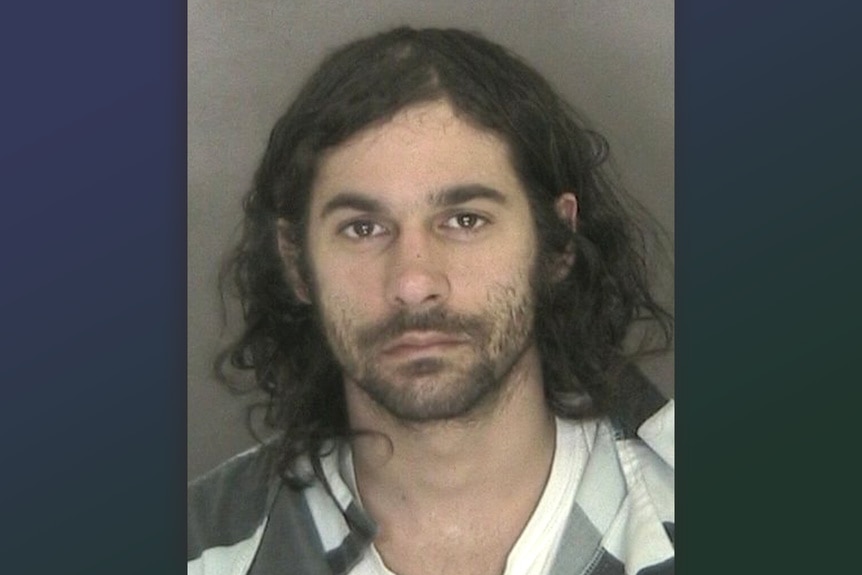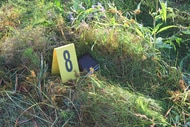Create a free profile to get unlimited access to exclusive videos, breaking news, sweepstakes, and more!
Climber’s “Brutal Murder” on Rocky Cliff Started With Argument Over Hat: “Senseless”
Geoffrey Farrar’s deadly fall to the bottom of a cliff looked like an accident, until police took a closer look at his injuries on Accident, Suicide or Murder.
Just moments before he was found barely alive at the bottom of a cliff, John Gregory saw Geoffrey Farrar having an argument.
“There’s this horrible noise,” Gregory, Farrar’s friend, said on Accident, Suicide or Murder, airing Saturdays at 8/7c on Oxygen. “And I go, ‘What is that?’ Then I see something on the ground. I didn’t recognize it as a person at first, because the head was so damaged. Then I noticed the climbing shoes. Then I knew it was Geoff.”
“I’m looking at the rock asking, ‘Did he fall? Was he climbing?’” Gregory said of Farrar, who was a regular on Carderock Recreation Area’s cliffs in Bethesda, Maryland.
Gregory was the one to call 911 about the apparent accident on Dec. 28, 2013. But what at first looked like a tragic accident quickly turned into a homicide investigation.
“The biggest question we had was how does a person fall from a serious height of 40 or 50, 60 feet, along a rock cliff, and only have injuries to two parts of his body and not a scratch on him anywhere else?” said Det. Sgt. Bob Steinheimer with the Major Crimes Unit of the U.S. Park Police, on Accident, Suicide or Murder.
Why did police initially think Geoffrey Farrar died in a climbing accident?
In the first hours of Geoffrey Farrar’s death investigation, police, as well as friends and fellow climbers, believed it to be an accident.
“People do fall. They do hurt themselves, particularly in the wintertime when the rock can be kind of wet or moist,” said Ken Otterbourg, former writer for Washington Post magazine, on Accident, Suicide or Murder. “And people can get cold, and their extremities aren’t working as well. Accidents do happen out there.”
Farrar, who was 69 years old when he died, also wasn't in the best of health.
“He was a great climber. But he had been having more health problems,” Gregory said. “He had arthritis. When you have arthritis, you don’t have the strength that you might have had when you were younger. People were a little suspicious that he hadn’t been in touch with his own abilities.”
But when the results of Farrar’s autopsy came back, they showed a different end to his life.
Evidence causes the medical examiner to rule Geoffrey Farrar's death a homicide
The autopsy of Geoff Farrar showed eight to 15 significant fractures to his skull, according to police.
“Rock creates a crushing blow, so the skull would be compressed and broken,” Steinheimer said. “The injuries to Mr. Farrar’s head are very specific, penetrating wounds through the scalp, through the skull into the brain. A rock can’t do that. So now we’re thinking this is something other than an accidental death.”
Besides his head wounds, Farrar only had lacerations on the backs of his hands.
“We would have expected to see injuries to the rest of his body, or scrapes. We saw none of that,” said Det. Glenn Luppino with the major crimes unit of the U.S. Park Police on Accident, Suicide or Murder.
The medical examiner believed the claw side of a hammer was the weapon used in Farrar’s murder.
“With the number of strikes to the skull, we felt like this was someone who had snapped, and was enraged,” Luppino said. “These were very significant strikes to his skull.”
A witness points police to suspect David DiPaolo
Several people witnessed an argument between Geoffrey Farrar and a fellow climber named David DiPaolo moments before Farrar’s murder, including his friend John Gregory, who said that an argument started because DiPaolo had allegedly stolen a hat from a park visitor.
“Geoff Farrar comes up, and he says, ‘Did you hear about what Dave did?’” Gregory recounted. “Geoff said, ‘Well, he got in a fight with somebody, and he stole the guy’s hat,' and I’m going, ‘What?’ Dave suddenly appears and starts arguing with Geoff. And Dave says, ‘You’re just an old man. Nobody likes you. You’re just a pain in the ass. Look, if you’re so upset, hit me. Go ahead, hit me.’ They argued back and forth some more and were getting nowhere, so Dave runs back and gets in his van.”
Gregory indicated to police that Farrar ended his friendship with DiPaolo right before his death, giving authorities a potential motive for murder.
“He remembers Geoff saying something along the lines of, ‘I’ve been a friend to him for 20 years, but that’s over now,’” Otterbourg said.
David DiPaolo pleads guilty to killing Geoffrey Farrar
Geoffrey Farrar was a mentor to David DiPaolo when he joined the climbing community at Carderock.
“He spent a lot of time with him. He worked at trying to get Dave to be a better climber and a better person,” Gregory said.
But after DiPaolo was diagnosed as bipolar, his ties with the community became strained.
After an incident where DiPaolo failed to tie a line properly causing a climber to be hurt, he was shunned from the climbing community.
“From what I understood, the only one who really looked out for Dave was Geoff Farrar,” Otterbourg said. “So the time the argument in the parking lot happened, Geoff told him he was done with him. And that was it. He wasn’t going to stand up for him anymore.”
Breaking that tie turned out to be fatal for Farrar. Gregory also put DiPaolo at the scene of the crime after the fall.
“John Gregory also tells the detectives that right after he saw Geoff on the ground, he turned around a corner of the cliffs and saw Dave DiPaolo,” Otterbourg said.
Gregory provided police with another piece of evidence: DiPaolo had access to hammers.
“Well, he worked as a framing carpenter in British Columbia,” Gregory said. “And I said, ‘Sure, I bet he had a framing hammer.’ He might have his tools with him.”
DiPaolo fled to New York State, but on Jan. 8, 2014, police located him.
“Eventually he came around and told us that he went to the bottom of the cliff to talk to Geoff, and as he walked around the corner, Geoff immediately grabbed him by the throat and started to choke him,” Luppino said. “And David said he fell to the ground with Geoff on top of him.”
DiPaolo claimed he found a hammer on the ground and used it in self-defense against Farrar, but that didn’t match the medical examiner’s report.
“These were very significant strikes to [Farrar’s] skull,” Luppino said. “These weren’t made by someone who was just trying to get away.”
David DiPaolo was charged with voluntary manslaughter for Geoffrey Farrar’s death. In July 2016, he pleaded guilty and was sentenced to ten years in prison. He was released in early 2023.
Watch all-new episodes of Accident, Suicide or Murder on Saturdays at 8/7c on Oxygen.


































